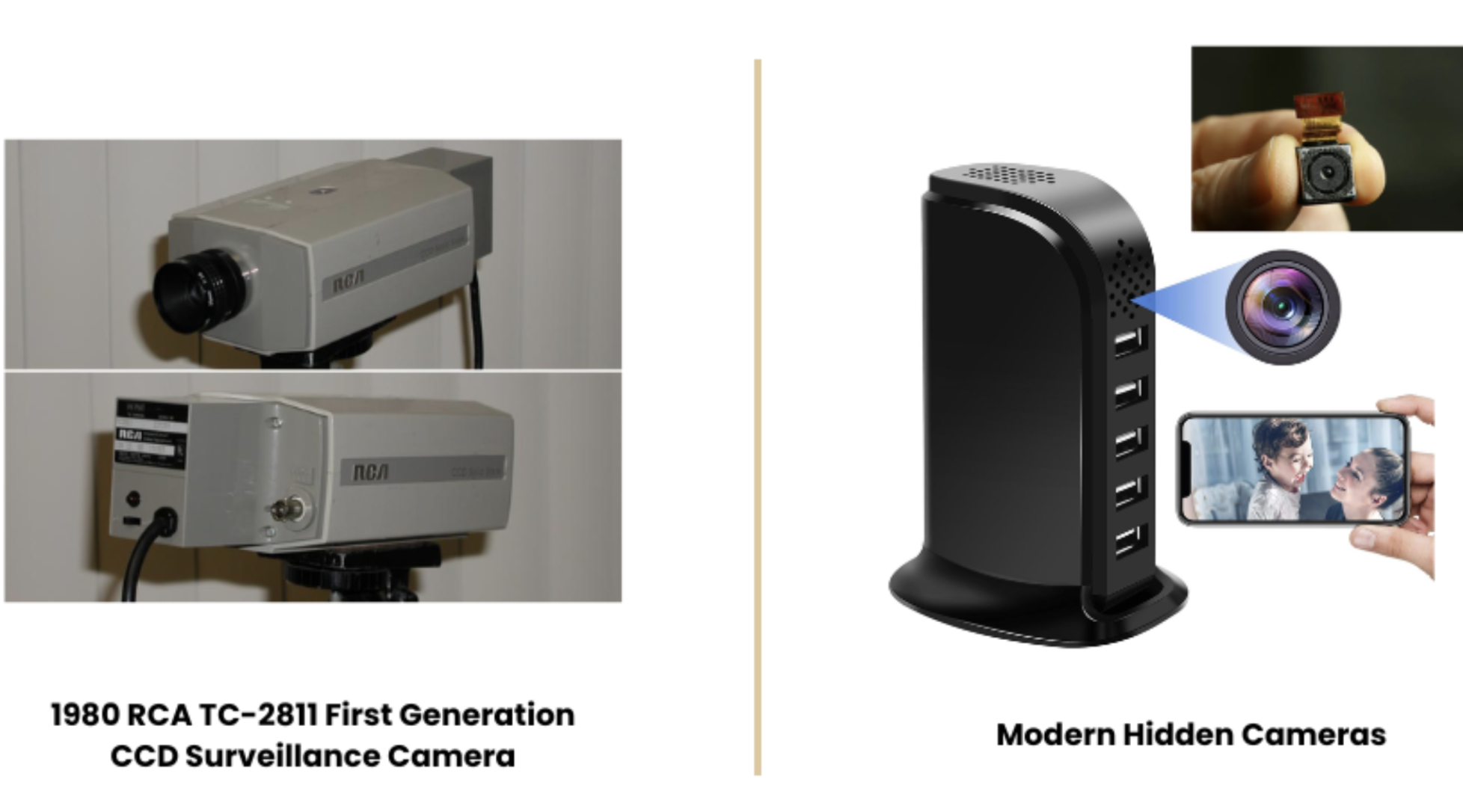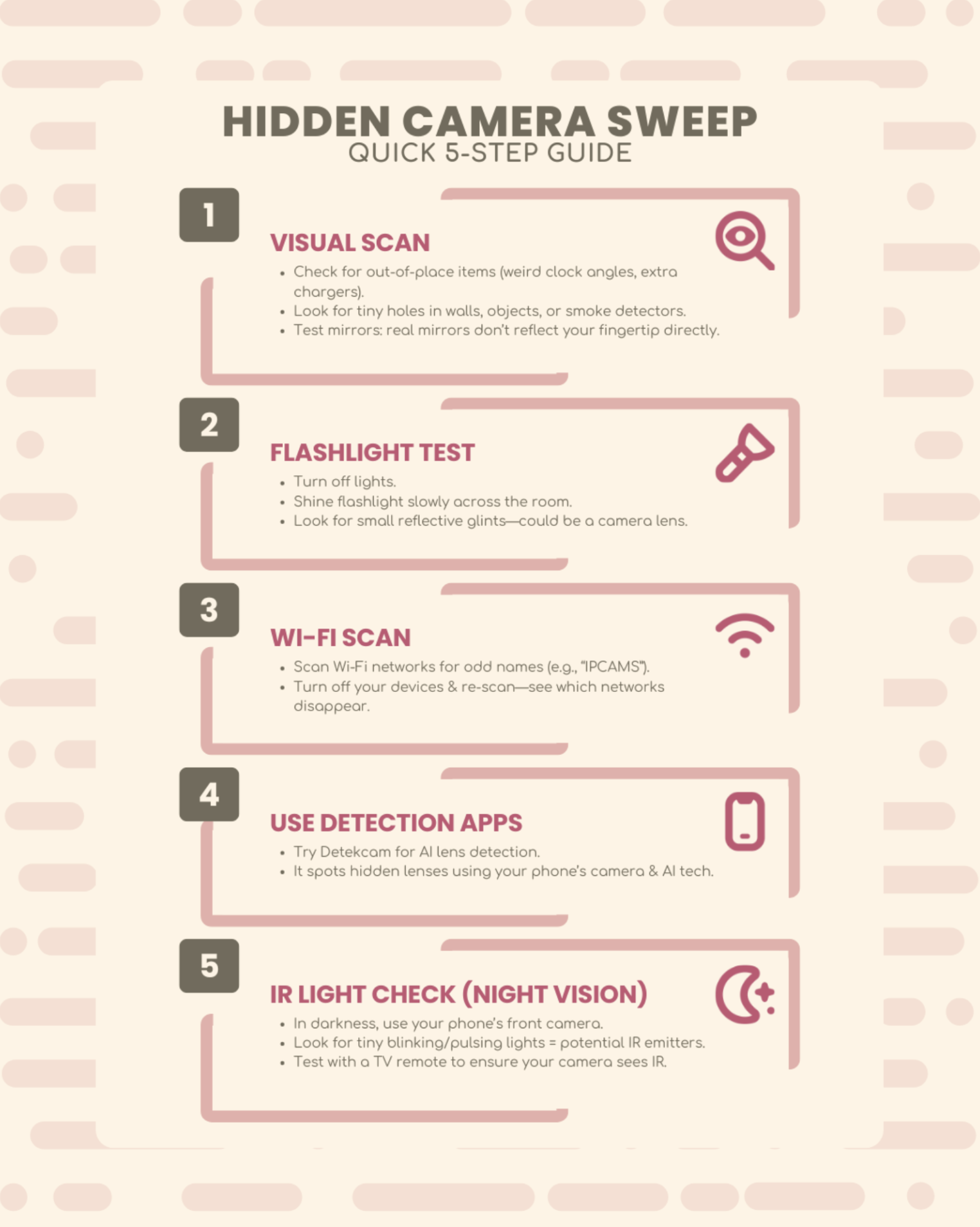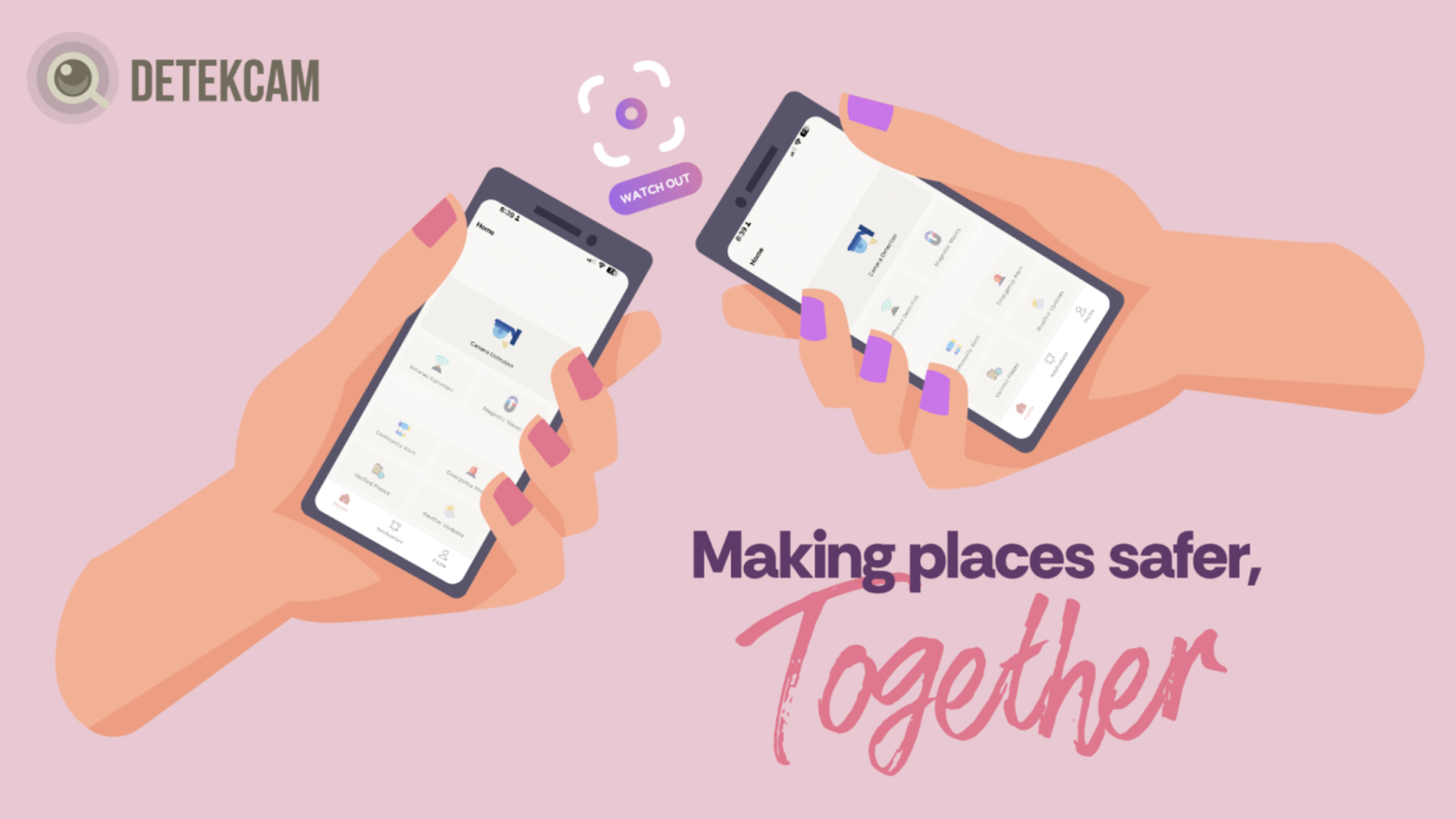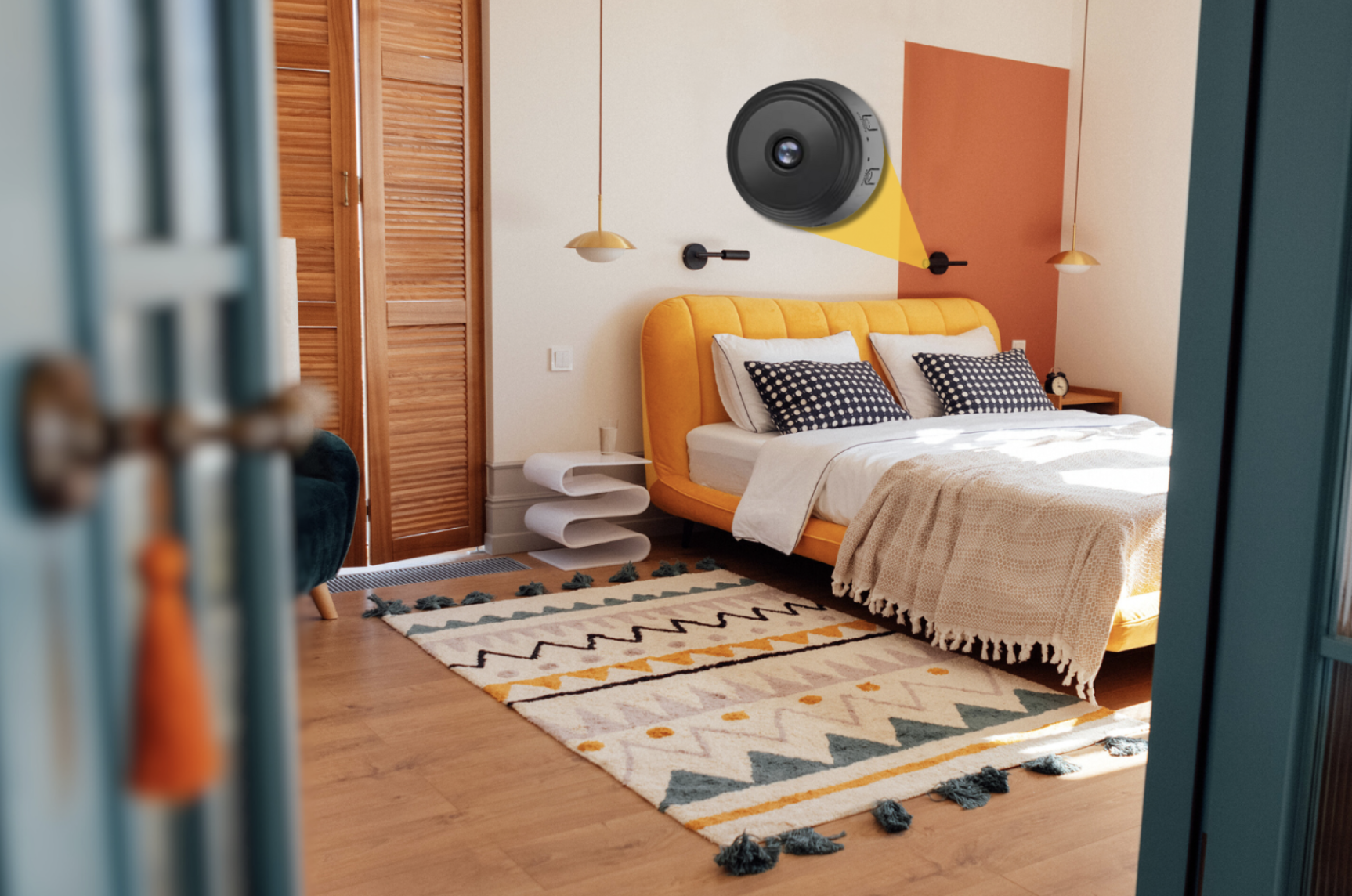Imagine this: You’ve just checked into a cozy Airbnb, excited for a relaxing getaway. You unpack, settle in, and then, a chilling thought crosses your mind…
“Is someone watching?”
In an increasingly connected world, privacy is at risk more than ever.
Spy camera technology has become incredibly sophisticated, shrinking to the size of a button and blending seamlessly into everyday objects.
The thought of an unseen lens capturing your most private moments is deeply unsettling. But here’s the empowering truth: you don’t have to live with that fear.
We’ll talk about how this guide is written to equip you with the knowledge and tools to understand the history, evolution, and, most importantly, the detection of hidden cameras, so you can reclaim your peace of mind and protect your personal space.
The Evolution of Spy Cameras
The journey from bulky, obvious cameras to today's nearly invisible spy devices is a testament to rapid technological advancement in surveillance technology.
In their early days, "spy cameras" were often just regular cameras modified for discreet use. They were still relatively large, required wires, and needed external power sources. Fast forward to the digital age, and everything changed.
- Miniaturization
- Wireless livestreaming
- Lengthy battery life

Compare an early spy camera, perhaps a clunky device, to a modern one disguised as a tiny USB charger or a smoke detector. The difference is astounding.
What was once the realm of secret agents is now accessible to anyone with an internet connection and a few dollars. Online marketplaces have made it disturbingly easy to acquire these devices, blurring the lines between legitimate security tools and instruments of privacy invasion.
Modern Tactics: Where Hidden Cameras Lurk in 2025
In 2025, hidden cameras are a very real threat in everyday spaces. The tactics used to conceal them are increasingly clever, preying on our trust and familiarity with common objects.
Common Locations to Be Wary Of:
- Hotels & Vacation Rentals (Airbnbs, VRBOs) are prime targets. Check bedrooms, bathrooms, and living areas.
- Public Changing Rooms & Restrooms require vigilance in fitting rooms at stores, public showers, and restrooms.
- Shared Workspaces & Offices If you use co-working spaces or temporary offices, consider the privacy of your immediate area.
- Gyms & Spas locker rooms and private changing areas can sometimes be compromised.
Unconventional Hiding Places & Clever Disguises
Hidden cameras blend in too and can be found in:
- Smoke Detectors & Carbon Monoxide Detectors hidden within the existing holes.
- USB Wall Chargers & Power Strips are incredibly common and provide a constant power source.
- Alarm Clocks & Digital Clocks in the display or speakers
- Picture Frames & Wall Art in small holes for the lens is easy to miss.
- Mirrors especially two-way mirrors, though less common, can conceal cameras.
- Light Bulbs & Lamps into the light fixture itself.
- Pens, Buttons, & Small Ornaments
- Soft Toys & Stuffed Animals particularly concerning in children's rooms.
- Plants & Vases within foliage.
Detecting the Undetectable: Countermeasures for 2025
Feeling overwhelmed? Don't be. While the threat is real, so are the solutions. You have the power to detect these devices and secure your space. It's about combining simple physical inspections with smart technological aids.
Your Step-by-Step Guide to a Thorough Hidden Camera Sweep:
-
Start with a Visual Scan (The "Once Over"):
- Look for anything out of place: Is there an alarm clock facing an odd direction? A smoke detector that seems slightly off? An extra USB charger plugged in?
- Scan for tiny holes: Look for pinholes in walls, ceilings, furniture, or objects that don't seem to have a purpose.
- Check wires and power sources: Are there wires leading to unusual places? Is a device plugged in where it doesn't make sense?
- Examine mirrors: Place your fingertip on the mirror's surface. If there's a gap between your finger and its reflection, it's a standard mirror. If your finger touches the reflection directly, it could be a two-way mirror (though rare, it's worth checking).
-
The Flashlight Test (Oldie but Goodie):
- Turn off all the lights in the room.
- Use your phone's flashlight (or a dedicated bright flashlight) and slowly scan every surface, especially suspicious objects.
- Look for a tiny reflection or glint: A camera lens will reflect light back like a tiny, bright dot, even in the dark. Move your flashlight slowly and at different angles.
-
The Wi-Fi Scan (For Wireless Cameras):
- Many hidden cameras transmit video wirelessly. Use your smartphone's Wi-Fi settings to look for unusual network names (e.g., "IPCAMS," "D-Link," or strings of numbers/letters you don't recognize).
- Turn off your own Wi-Fi devices: Temporarily disconnect your phone, laptop, etc., to see if any unknown networks disappear, indicating they might be local devices.
-
Leverage Smartphone Apps (Like Detekcam):
- This is where modern technology truly empowers you. Spy/hidden camera detector apps like Detekcam utilize your smartphone's camera and advanced AI algorithms to detect hidden lenses.
- How it works: Detekcam's AI Lens Detection is trained on vast databases of camera lenses, allowing it to identify even the most minute reflections or patterns indicative of a hidden camera. It analyzes your phone's camera feed in real-time, highlighting potential threats on your screen.
Detekcam goes beyond what the human eye can see, offering a layer of sophisticated detection that's constantly updated to combat new camera technologies.
-
Check for Infrared (IR) Emitters (For Night Vision):
- Many hidden cameras have infrared LEDs for night vision, which are invisible to the naked eye.
- Use your phone's front-facing camera: Most phone cameras can pick up IR light. In a dark room, point your front camera at suspicious areas. If you see tiny, pulsing dots of light on your screen, it could be an IR emitter from a hidden camera. (Note: Some newer phone cameras filter out IR, so test with a TV remote first to see if your phone can detect its IR signal).

Staying Updated is Key
The technology used by intruders is always evolving, and so should your detection methods. Regularly update your detection apps, read up on new concealment tactics, and share information with trusted friends and family.
The Future of Privacy and Protection
The fight against hidden camera surveillance is an ongoing one, a constant dance between innovation in concealment and advancement in detection.
As cameras become even smaller, more energy-efficient, and capable of incredibly discreet integration, the challenge will intensify. We might see cameras embedded in even more unexpected materials or utilizing advanced AI for even more seamless camouflage.
However, the future of privacy isn't bleak. It's a future where awareness, vigilance, and proactive measures become our strongest shields. Just as the technology for intrusion evolves, so too does the technology for protection. AI, which enables sophisticated hidden cameras, is also our most powerful ally in detecting them. We can anticipate even more precise and user-friendly detection tools, perhaps integrating augmented reality to highlight threats in real-time, or even passive environmental scanners.

The most important takeaway is this: you are not helpless. By staying informed, being vigilant, and utilizing the powerful tools available, you can significantly reduce your risk. If you ever suspect you've been a victim of voyeurism or privacy invasion, remember you're not alone. Seek support from trusted individuals, law enforcement, and victim support organizations. Your privacy is a fundamental right, and there are resources available to help you protect it!
